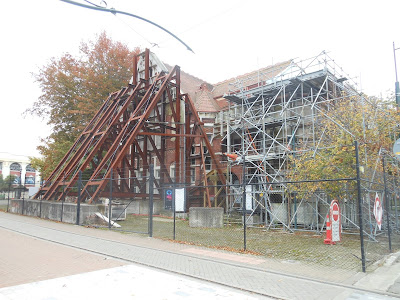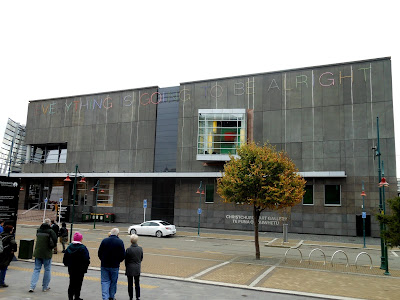Hahahahaha. This is from our final dinner at the private home of "Gate 1 friends" (I forget their names.) The hosts gave us special assignments during the dinner, and mine was to make sure everyone's water glasses remained full. What an attractive apron they gave me to wear!
This special dinner was our final tour farewell event. It was an elegant affair and we all had a marvelous time.
We departed Tekapo after breakfast, and arrived in Christchurch before noon. Greg gave us another reason we did okay to have missed Franz Josef Glacier: The standard tours that go there have only a smidgen of time to see Christchurch, whereas we would have most of an entire day. As it turned out, Janet and I enjoyed this day in the town immensely, so perhaps we did come out better by seeing Mt Cook Village yesterday and now Christchurch.
Our first stop in Christchurch was the Earthquake Museum. Peter, our bus driver and tour guide, has lived in Christchurch all his life, so he gave us tons of interesting info and fun stories, and knew where to drive us to show us the highlights.
The big "recent" earthquake was on Feb 22, 2011, but eight years later, the city was still not nearly recovered. The 6.7 quake caused widespread damage and 185 people died. The central city and eastern suburbs were badly affected, with damage to buildings and infrastructure already weakened by the magnitude 7.1 Canterbury earthquake of Sept 4, 2010. Significant liquefaction affected the eastern suburbs, producing around 400,000 tons of silt.
I did not take very many photos in the museum, but I got a kick out of the "After Shock" beer. The caption tells how they made this beer just four days after the 7.1 earthquake, on Sept 8, 2010, when a 5.1 aftershock knocked out their electricity. The loss of temperature control meant less water used, which raised the alcohol content in this batch to precisely 7.1%. (Thus, it's actually 14.2 proof.)
This display shows why the South Island is earthquake-prone. The Pacific and Australian plates continue to push up against each other. Records show that a 7.0+ earthquake hits the island on average of once every 10 years.
This display illustrates how buildings now have "shock absorber" bases, so they can move to absorb the jolts. It's called Base Isolation.
We then went to our hotel, and it was as centrally located as could possibly be. Out our window, we looked down on the Christchurch Cathedral, famous for not yet having been "dealt with" following extensive damage from the earthquake eight years earlier (see the right of it).
We were on our own to find lunch. Janet and I walked a short distance to New Regent St, with blocked-off traffic and many shops.
The trolley came right down New Regent St!
This view is also out our hotel window, and in the direction of the walk we all took with Greg in the afternoon (to the west). You can still see the crumbled end of the cathedral in the far left of the photo.
We hadn't walked far before we could see more of the cathedral damage. The city has yet to resolve whether they should restore the original structure, or tear it down and start over. It has become a cozy home for birds.
There's Jim as the tram is approaching. We continued west on our walk (behind me), toward the Avon River, Christ's College, and the huge Hagley Park.
One of many buildings we saw that were still boarded up for the past eight years, awaiting a restoration fate. The citizens cannot decide who should pay for the repairs/reconstructions.
Major renovation still underway, eight years later.
A statue to Robert Scott, who died during his quest to be the first to reach the South Pole. He did reach it, but five weeks after Norwegian Roald Amundsen. Brit Scott led a party of five which reached the South Pole on Jan 17, 1912, but they never made it back to their base camp.
Crossing the Avon River, where people "punt" as they do on the English Avon River.
We passed a Māori totem with a phrase meaning a farewell to a chief.
The words across the top of the art gallery are: "Everything will be all right."
Extensive restoration work in progress.
Inside the Christ's College campus, dating from 1850.
In their chapel, this stained glass window had representations of many famous explorers, artists, scientists, and so on.
We reached the Botanical Gardens, and here is the Peacock Fountain (1911), named for a politician and philanthropist.
Along the wall of the large park was this memorial to the victims of the Muslim shootings just three weeks earlier. We admired that they had such an outpouring of sympathy for the 51 victims.
More signs of support: "We stand together with our Muslim brothers and sisters."
Such a tragedy they were all suffering through.
The Bridge of Remembrance, honoring those who died in the first world war.
Looking back from the bridge.
Even the Nespresso store was still boarded up eight years after the earthquake. Hey Nestlé, get with it!
At about this point, our guided walk was over. Jim and Cynthia joined Janet and me who decided to walk to a super market several blocks to the south, to buy souvenirs. It was a long way, but seemed worth it because we bought many of the Whitman's chocolate bars. We decided to Uber back to the hotel.
For dinner, we traveled to a suburb in the hills to a private family. It was truly special.
The men were recruited to help serve the dishes from the kitchen, while the rest of us lined on through to fill our plates. Everything was wonderful.
An enjoyable final evening.































No comments:
Post a Comment